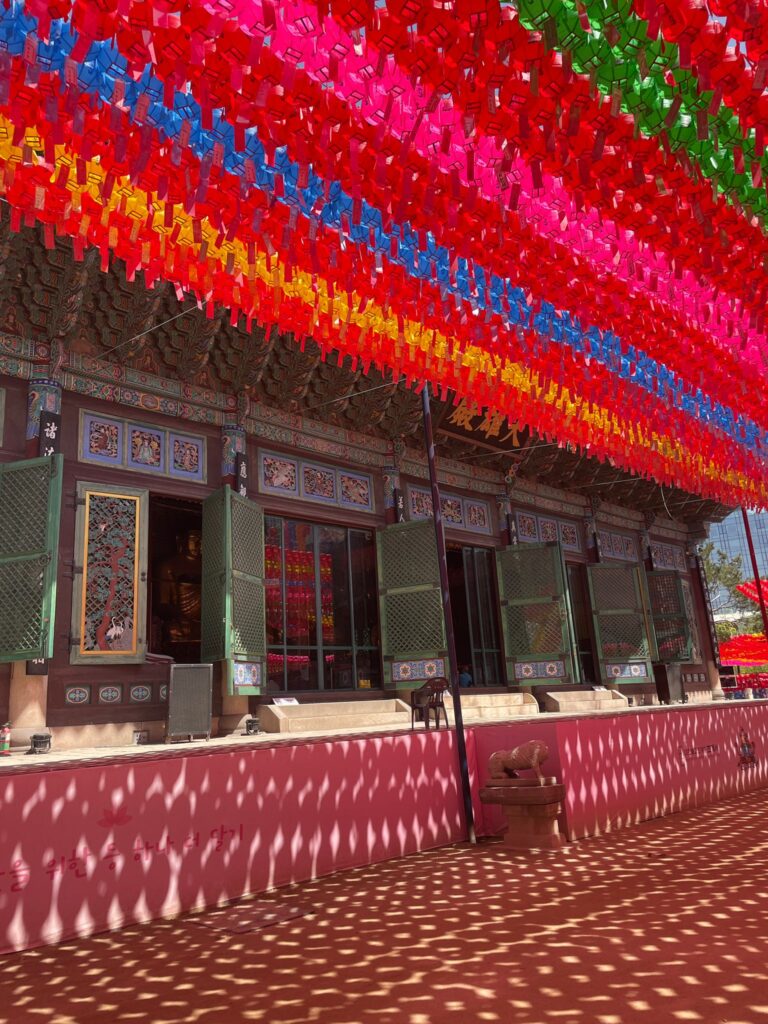One Day in Seoul: 24 Hour Itinerary for South Korea’s Capital
Whether you have a one day layover in Seoul, or you’re focusing on the rest of South Korea giving you just 24 hours in the capital, there are plenty activities to do here. I’ve lived in South Korea since August 2023 and can give you some itinerary ideas for one day in Seoul.
If you’re looking to dive into South Korean history, traditions and culture, then look no further than the Jongno-gu district of Seoul. This is the capital’s historic centre housing attractions such as Hanok Traditional Village, Changgyeonggung Palace and South Korea’s most iconic attraction, Gyeongbokgung Palace.
Elsewhere, you can enjoy great views of Seoul from N Seoul Tower (Namsan Tower), sports lovers may enjoy the Olympic Village, foodies will love Myeongdong, whilst the capital is full of underrated gems and temples.
Here I’ll help you optimise your time in Seoul with my knowledge of the best places to visit in a day.
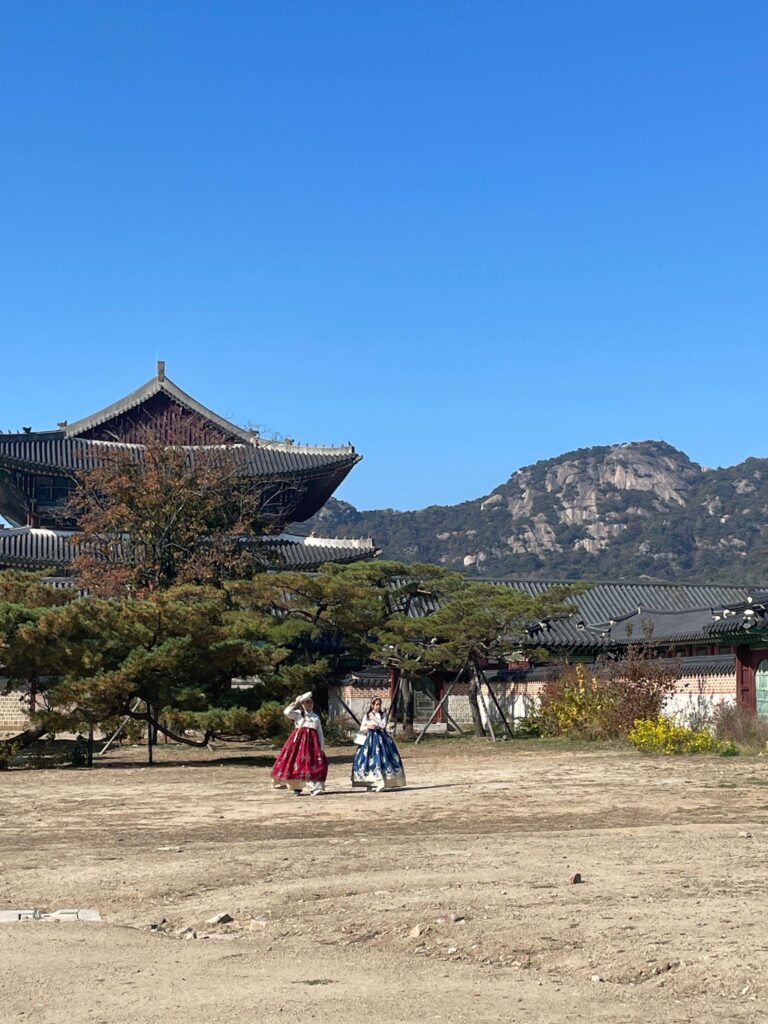
One Day in Seoul Itinerary: The Highlights
Activities: Gyeongbokgung Palace, Bukchon Hanok Village, N Seoul Tower, Myeongdong
It’s natural that if you only have a single day in the city, you will want to focus on the best parts. Even if you don’t have a full day, you can still follow this itinerary and squeeze a lot in. This is pretty much what I did during my first of many solo visits to Seoul, and I highly recommend it for newbies to this massive city.
Morning
Gyeongbokgung Palace
Recommended visit time: 2 hours
Nearest metro station: Gyeongbokgung (Line 3)
A 600 year old palace, and the largest built by the Joseon Dynasty, it is undergoing a lengthy restoration process, with attempts to bring it back to how it appeared before the Japanese destroyed much of the complex.
You can easily get lost amongst the many big buildings here. Many tourists will be wearing hanboks, the traditional Korean clothing often worn for major celebrations such as Chuseok. You can easily rent one at one of the many hanbok rental stores near the palace. As soon as you come out of Gyeongbokgung Station, you will be bombarded by hanbok rental shops. It will be a lot more challenging to get to the palace without seeing one, so don’t worry about missing out.
Some of the highlights include the imposing Geunjeonjeong Hall, home to the king’s throne. Also check out the 15-minute long changing of the guard ceremony at Gwanghwamun Gate which takes place at 10am and 2pm every day except Tuesday (when the palace is closed).
My personal favourite spot within the palace was Hyangwonjeon. This beautiful pavilion is surrounded by a small lake with the mountains looming over it in the background. Just look at my picture below and you’ll see what I mean.
Bukchon Hanok Village
Recommended visit time: 1-2 hours
Nearest metro station: Anguk (Line 3)
Hanoks are traditional Korean buildings. And Bukchon Hanok Village is full of them, so you can really feel like you’re in Korea when you’re here.
It is mostly residential with several locals living there. However it attracts a lot of tourists, and therefore a lot of buildings have been converted into guesthouses, cafes and restaurants.
To be honest, if you’re only spending one day in Seoul then you’ll struggle to get good pictures with so many tourists and locals alike to be found here. Get in very early for the best snaps.
If you want a similar aesthetic with smaller crowds, you can try Ikseondong Hanok Village instead. Smaller doesn’t mean small though. Some of the cafes were pretty busy. I was there on the day I finished writing this article from around 10:30am-11am during a hot spring morning where it was still tricky to find a quiet part without other people.
Ikseondong is undoubtedly less touristy than Bukchon however.
On a side note, Spring is the best time to visit South Korea with its pleasant weather and April marking the famous cherry blossom season.
Afternoon
N Seoul Tower (Namsan Tower)
Recommended visit time: 1-2 hours
Nearest metro station: Myeongdong (Line 4)
One of the best viewpoints in Seoul comes from the top of N Seoul Tower. It is located on top of Namsan Mountain which often leads to people calling it Namsan Tower.
It takes around 45 minutes to reach the tower from Myeongdong Station, and you will need to hike a little to get there (or take the cable car).
You don’t even need to enter the tower for great views. You can see the surrounding city from the top of Namsan Mountain. If you do enter, it costs ₩21,000 (£12.22/US$15.41) for adults or ₩16,000 (£9.31/US$11.74) for children as of April 2024.
The views aren’t the only reason to come here. They host regular (free) entertainment at the tower’s base. I saw a martial arts performance with a Korean man wearing traditional clothing swinging a sword, much to the entertainment of the surrounding crowd. It’s a pretty cool thing to see, and you won’t find that in France, right??
Evening
Myeongdong Street Markets
Recommended visit time: 1 hour
Nearest metro station: Myeongdong (Line 4)
Myeongdong isn’t just the place to get off for N Seoul Tower. It’s also one of the biggest attractions in the capital in its own right. Aside from the shops (Shinsegae and Lotte are major department stores), Myeongdong is famous for its street markets.
Walk down Myeongdong-gil (Myeongdong Street) and you will find dozens of food stalls selling all your Korean street food favourites. Perhaps one of the most notable snacks for sale is Korean fish bread, which is bread (duh) with a red bean paste filling. Koreans are mad about this and I’ve seen it all over the country at street stalls and in supermarkets.
You’ll also find some slightly less Korean foods here. One stall which caught my eye was the one selling Oreo churros.
I absolutely love churros, but don’t particularly like Oreo. First world problems at their finest.
There was one stall where a man blasted meat skewers with a flame gun. Pretty cool stuff to watch in person.
By the time you’ve finished here, you can head back to Incheon International Airport (or wherever you may be heading next) satisfied with the knowledge that you’ve experienced a good chunk of Seoul in just one day.
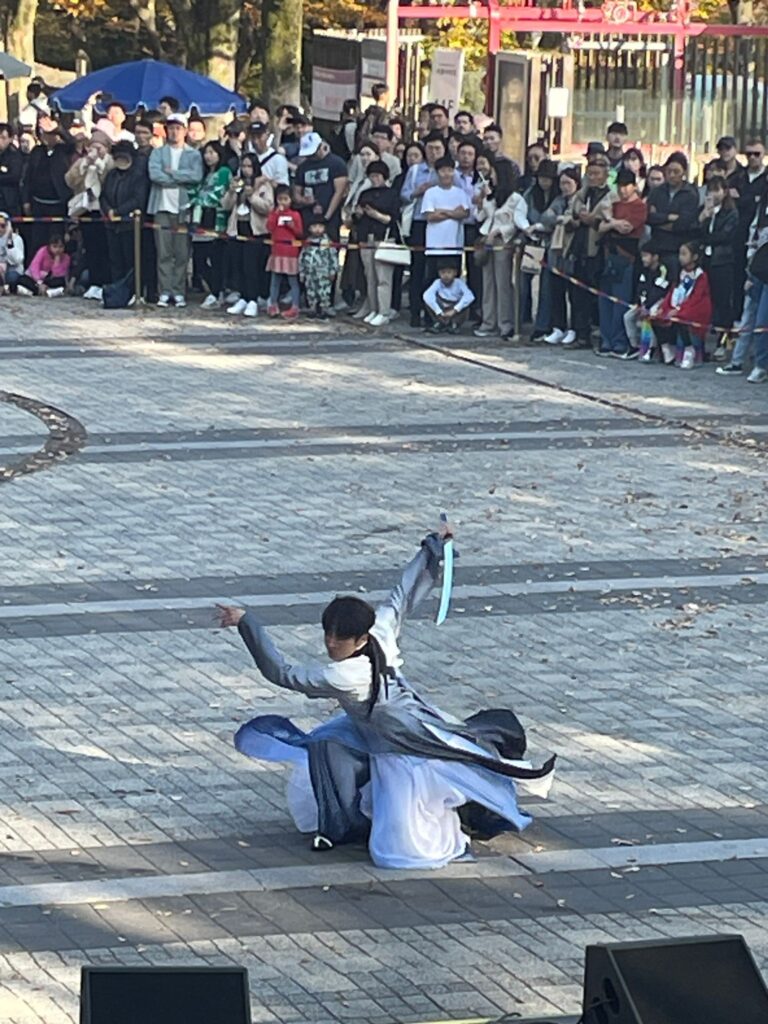
One Day in Seoul Itinerary: History and Korean Culture Enthusiasts
Morning
Gyeongbokgung Palace
Recommended visit time: 2 hours
Nearest metro station: Gyeongbokgung (Line 3)
Just as with the highlights tour, start your day at Gyeongbokgung Palace.
National Folk Museum of Korea
Recommended visit time: 2-3 hours
Nearest metro station: Gyeongbokgung (Line 3)
Located within the Gyeongbokgung Palace grounds, this museum is the perfect place to learn about how Koreans lived their lives throughout the centuries up until the modern day.
There are almost 100,000 artifacts here, so quite a lot to check out. History enthusiasts can easily spend a few hours here, although with only a day to spend, you’ll need to limit your time.
Afternoon
Bukchon Hanok Village
Recommended visit time: 1 hour
Nearest metro station: Anguk (Line 3)
The history and culture itinerary shares a couple of activities with the highlights itinerary. Follow up your Gyeongbokgung Palace and National Folk Museum trip with Bukchon Hanok Village.
I’d recommend limiting your visit to 1 hour, just to ensure you have time to squeeze more activities in. After all, the museum will take a good chunk of your time.
Gwanghwamun Square
Recommended visit time: Under 1 hour
Nearest metro station: Gwanghwamun (Line 5)
This large square is primarily a cultural space, with impressive statues of Admiral Yi Sun-sun and revered King Sejong the Great of the Joseon Dynasty found here. King Sejong is one of the most important figures in Korean history, and the creator of the hangul (Korean alphabet).
It also has green spaces to rest in and watch the world go by, as well as fantastic views of Gyeongbokgung Palace in the background and several events and activities taking place.
Evening
Changgyeonggung Palace
Recommended visit time: Under 1 hour
Nearest metro station: Hyehwa (Line 4)
Open from 9am-9pm every day except Mondays, Changgyeonggung Palace is the perfect place to complete your history tour of the capital.
This is another impressive complex built during the reign of Sejong the Great. And you can really see why he was so popular given the beauty of this place.
The most famous spot is Honghwamun Gate. It’s the main gate to the complex, and absolutely lives up to its reputation with its sheer beauty.

One Day in Seoul Itinerary: Sports Lovers
Morning
Seoul Olympic Park
Recommended visit time: 1-2 hours
Nearest metro station: Olympic Park (Lines 5 and 9)
Fellow sports fans will enjoy visiting Seoul’s Olympic Park, which was built for the 1988 games taking place here.
Whilst not the nearest station, I enjoyed coming out at Jamsil Station by Lotte World and walking down Olympic-ro for ten minutes or so with every country’s flag flying along the road.
Once you get to the park, the Olympic Park World Peace Gate is the main entry point. There are statues of the mascot outside (Hodori the tiger) alongside a white cat.
You can enter the complex from here and walk around the remaining Olympic venues, plus a plaza full of flags representing all the competitors. It still seems to have a use for sports. When I was there, several youngsters were riding bikes around the plaza.
The Olympic Park is free to enter and open 24/7 so why not check out a bit of sporting history to start the day.
The only downside is that the Seoul Olympic Museum is now closed and won’t reopen until February 2026. We didn’t know this until we went there and a local told us this was the case.
Afternoon
Visit the Seoul World Cup Stadium
Recommended visit time: 1-2 hours
Nearest metro station: World Cup Stadium (Line 6)
This 66,000-capacity stadium was built for the 2002 World Cup which was held across South Korea and Japan. It hosted one of the semi-finals, during which South Korea were narrowly defeated by Germany.
The stadium has remained in use ever since, becoming home to the South Korea national team and local K-League side FC Seoul.
You can even go on a tour of the stadium for just ₩1,000 (£0.58/US$0.73) where you can see the usual sites to be expected on a stadium tour: the dressing rooms, the tunnel, the pitch etc. You can’t really go wrong for that price.
Afternoon/Evening
Take in a Baseball Game at Jamsil Stadium
Recommended visit time: 3 hours
Nearest metro station: Sports Complex (Lines 2 and 9)
Baseball is massive in South Korea, and you shouldn’t visit the country without attending a game.
There are games taking place every day except Monday, and the most popular place to attend a fixture is at the Jamsil Baseball Stadium, best known for its raucous atmosphere.
The ground is home to two KBO League teams: LG Twins and Doosan Bears. The KBO League is the highest level of baseball in South Korea.
You can bring drinks into the ground, and there are no shortage of food options here.
Matches are around 3 hours long and start at times varying between 2pm and 6:30pm.
Don’t miss out on this highlight of the Korean sporting landscape.

One Day in Seoul Itinerary: Foodies
Morning
Gwangjang Market
Recommended visit time: 1-2 hours
Nearest metro station: Jongno 5(o)-ga (Line 1)
Travel to Gwangjang Market to experience one of South Korea’s premier foodie hotspots. Every Korean favourite such as gimbap (rice and seaweed rolls) and tteokbokki are served here. The latter is a rice cake covered in spicy sauce, although I wish you luck if you’re going to attempt pronouncing “tteokbokki” on the back of a few sojus.
The bustling markets certainly aren’t short of punters. It can be a tight squeeze here if you arrive later in the day.
You can book food tours with local guides if you wish to experience the best of what this place has to offer. I’ve done many tours in many countries and locals always know the best places to go and things to do to enhance your experience.
You can even try live octopus squiggling around on your plate if you’re feeling brave enough.
Afternoon
N Seoul Tower (Namsan Tower)
Recommended visit time: 1-2 hours
Nearest metro station: Myeongdong (Line 4)
You’ll be feeling pretty stuffed after a morning at Gwangjang Market. Therefore I’d recommend the short hike up towards N Seoul Tower to burn off your breakfast and prepare for your evening food instead.
Evening
Myeongdong Street Markets
Recommended visit time: 1 hour
Nearest metro station: Myeongdong (Line 4)
After a few hours of rest, you should head to Myeongdong to check out the street markets. They’re one of the most fun places in Seoul, and one of my favourites to experience the local culture.
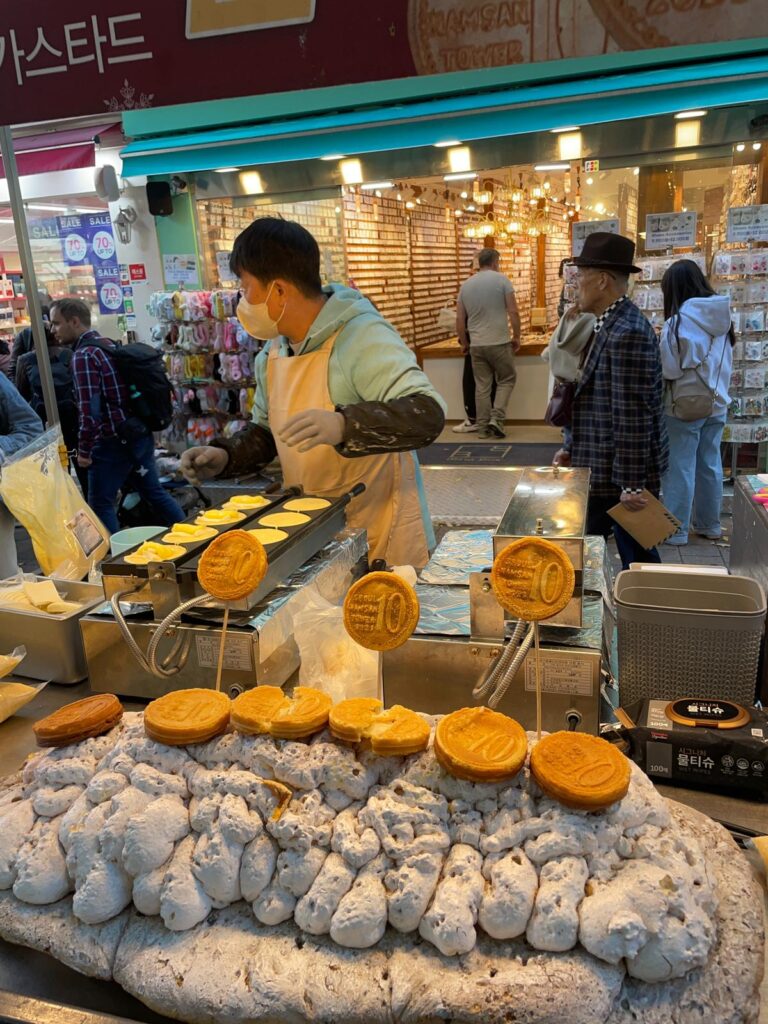
One Day in Seoul Itinerary: Religious Explorers
Morning
Bongeunsa Temple
Recommended visit time: 1 hour
Nearest metro station: Bongeunsa (Line 9)
One of my favourite Buddhist temples in South Korea, perhaps topped only by Beopjusa Temple in the country’s centre.
If you visit the temple independently, it will take under an hour. Although I’d recommend taking this excellent walking tour of the wider Gangnam area which also includes other nearby attractions including the famous Gangnam Style statue, and COEX Mall Starfield Library.
I did the tour in January 2024 and the guide Marko had an excellent knowledge of the temple, its history and what everything meant.
You can enter through a gate where you will pass statues of the Four Heavenly Kings: Buddhist deities that often stand at the entrance to Buddhist temples.
Walk further inside and you will hear the mystical sounds of Buddhism, and see colourful pictures depicting Buddha’s journey to enlightenment.
Head past the temple itself and you can ascend to the top of the complex where a large statue of Buddha stands, surrounded by thousands of smaller ones. It’s a pretty awesome site and a great spot for some photos.
Jogyesa Temple
Recommended visit time: 1 hour
Nearest metro station: Anguk (Line 3)
Located in popular Insadong, this is one of the most popular temples in Seoul. It is near other famous spots including Gyeongbokgung Palace and Gwanghwamun Square.
Jogyesa Temple is a member of the templestay program where you can stay overnight in Buddhist temples and participate in several Buddhist teachings and cultural activities.
Check the link in the last paragraph for the latest information on programs. At the time of writing, there were no advertised programs upcoming, although Beopjusa Temple which I visited last week had a few with prices ranging from ₩30,000-₩100,000 (£17.52-£58.39 or US$22.16-US$73.88) to give you a rough idea of price.
Afternoon
Gwangjang Market
Recommended visit time: 1-2 hours
Nearest metro station: Jongno 5(o)-ga (Line 1)
Walk for half an hour towards Gwangjang Market for lunch. Enjoy some typical local food and get ready to enjoy one more temple experience before heading back.
Afternoon/Evening
Bongwonsa Temple
Recommended visit time: 1 hour
Nearest metro station: Sinchon (Line 2)
At the base of Ansan Mountain lies Bongwonsa Temple.
Unlike the others on this list, Bongwonsa is famous for its greenery. The buildings here are nestled amongst the trees.
The temple was initially built 1,000 years ago, although it was rebuilt in 1748. Some buildings were later destroyed in the Korean War, and later a fire. The most modern buildings are around 30 years old.
It’s free to enter, and this is one of the most spectacular buildings in Seoul. So if you love a good temple then you’ll certainly like it here.
Best of all, this one hasn’t caught the attention of most tourists yet, making it a more authentic Korean Buddhist experience.
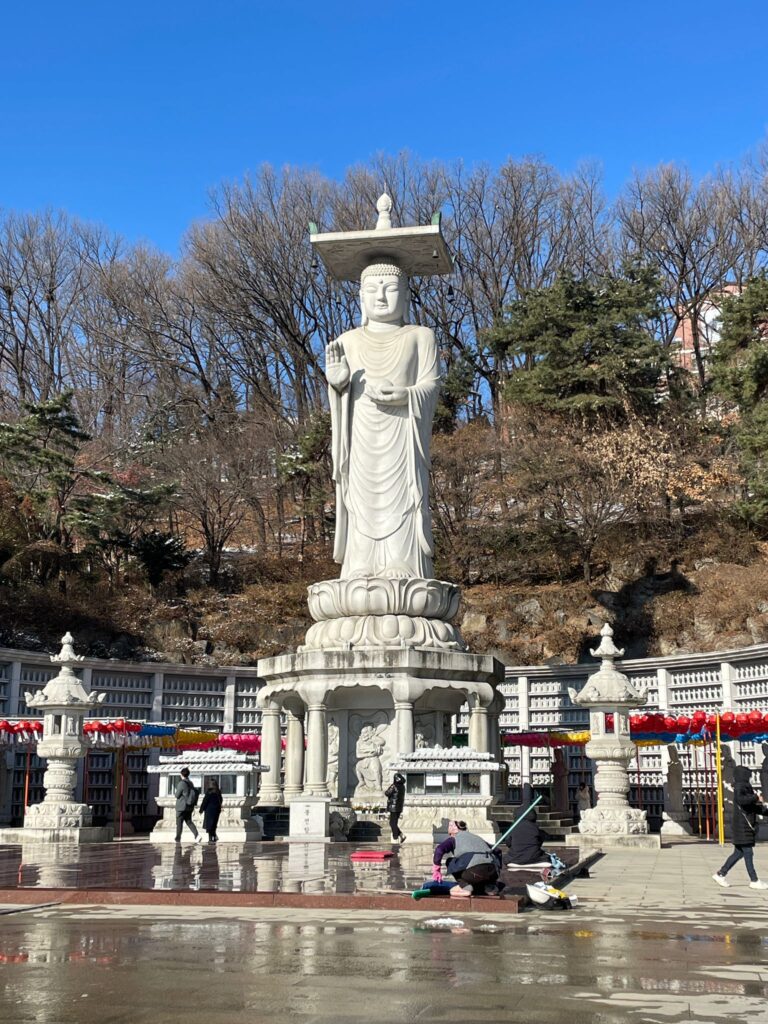
How to Get Around Seoul in a Day
Seoul is absolutely massive. Fortunately the Seoul subway system works excellently once you get used to it. Although I will warn, it takes a bit of getting used to.
You can buy a Tmoney day pass which allows you to use the metro up to 20 times a day for ₩15,000 (£8.70/US$10.84).
To be honest, you don’t need this. A one-way metro ticket costs around ₩1,500-2,000 on average meaning you will need to take at least 8 journeys in a day to make the Tmoney pass worthwhile. I’ve never used the Seoul metro more than around 5 times in a single day when I head up there for a day trip or stay over for the weekend.
The one annoying thing about one-way tickets is that you will pay an extra ₩500 deposit every time you purchase a ticket. This is refundable whenever you arrive at your destination, but it’s extra hassle to go out of your way, queue up at a refund machine and exchange your card for a ₩500 coin.
If that really bothers you, then sure, just buy a Tmoney day pass. But purchasing one-way tickets is easily the cheaper option in most cases.
In any case, you will be able to enjoy some sightseeing, history, sports, shopping, food, temples or whatever else piques your interest during your self-guided day tour of Seoul.
Final Thoughts on Seoul
I’ve been teaching English in South Korea since August 2023. I first visited the capital around two months later and must admit it took time to warm on me.
During my first trip I went to Gyeongbokgung Palace, then dashed to N Seoul Tower, raced through the markets of Myeongdong and ultimately went back to explore Gangnam before taking the bus back to where I live.
In hindsight I would’ve skipped the Gangnam part of that itinerary and spent more time around Gwanghwamun Square and the local hanok villages.
I had ten hours on that particular day, and didn’t even plan the Gangnam part well… I’d heard that there was a Gangnam Style statue near the station so I went to Gangnam Station to check it out. Yet I didn’t find it because… it wasn’t there!
The Gangnam Style statue is actually by Bongeunsa Station. You can easily combine a trip here with Bongeunsa Temple and the popular Instagram spot Starfield Library which is in the COEX Mall, literally a stone’s throw away from the Gangnam Style statue.
Anyway, I’ve been to Seoul several times since and done dozens of interesting things, many of which I’ve shared with you above. Perhaps I’ll expand this list in the future as I discover more awesome spots to share with you guys!
It also acts as a good base for day trips, including to the DMZ which is well worth visiting.
If you also wish to teach English in South Korea, here are the requirements. With the exceptions of fruit and meat, this is a very affordable country and I’m yet to spend more than £45 (₩78,000/US$56) on a day trip to the capital. That includes around £15 (₩26,000/US$19) for buses to and from my home city.
